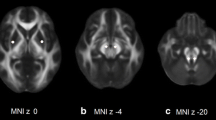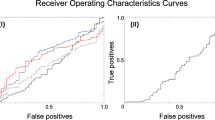Abstract
Objective
To develop a decision tree based on standard magnetic resonance imaging (MRI) and diffusion tensor imaging to differentiate multiple system atrophy (MSA) from Parkinson’s disease (PD).
Methods
3-T brain MRI and DTI (diffusion tensor imaging) were performed on 26 PD and 13 MSA patients. Regions of interest (ROIs) were the putamen, substantia nigra, pons, middle cerebellar peduncles (MCP) and cerebellum. Linear, volumetry and DTI (fractional anisotropy and mean diffusivity) were measured. A three-node decision tree was formulated, with design goals being 100 % specificity at node 1, 100 % sensitivity at node 2 and highest combined sensitivity and specificity at node 3.
Results
Nine parameters (mean width, fractional anisotropy (FA) and mean diffusivity (MD) of MCP; anteroposterior diameter of pons; cerebellar FA and volume; pons and mean putamen volume; mean FA substantia nigra compacta–rostral) showed statistically significant (P < 0.05) differences between MSA and PD with mean MCP width, anteroposterior diameter of pons and mean FA MCP chosen for the decision tree. Threshold values were 14.6 mm, 21.8 mm and 0.55, respectively. Overall performance of the decision tree was 92 % sensitivity, 96 % specificity, 92 % PPV and 96 % NPV. Twelve out of 13 MSA patients were accurately classified.
Conclusion
Formation of the decision tree using these parameters was both descriptive and predictive in differentiating between MSA and PD.
Key Points
• Parkinson’s disease and multiple system atrophy can be distinguished on MR imaging.
• Combined conventional MRI and diffusion tensor imaging improves the accuracy of diagnosis.
• A decision tree is descriptive and predictive in differentiating between clinical entities.
• A decision tree can reliably differentiate Parkinson’s disease from multiple system atrophy.




Similar content being viewed by others
References
Hughes AJ, Daniel SE, Lees AJ (2001) Improved accuracy of clinical diagnosis of Lewy body Parkinson’s disease. Neurology 57:1497–1499
Nicoletti G, Fera F, Condino F et al (2006) MR Imaging of middle cerebellar peduncle width: differentiation of multiple system atrophy from Parkinson disease. Radiology 239:825–830
Schulz JB, Skalej M, Wedekind D et al (1999) Magnetic resonance imaging-based volumetry differentiates idiopathic Parkinson’s syndrome from multiple system atrophy and progressive supranuclear palsy. Ann Neurol 45:65–74
Ghaemi M, Hilker R, Rudolf J et al (2002) Differentiating multiple system atrophy from Parkinson’s disease: contribution of striatal and midbrain MRI volumetry and multi-tracer PET imaging. J Neurol Neurosurg Psychiatry 73:517–523
Menke RA, Scholz J, Miller KL et al (2009) MRI characteristics of the substantia nigra in Parkinson’s disease: a combined quantitative T1 and DTI study. NeuroImage 47:435–441
Yoshikawa K, Nakata Y, Yamada K et al (2004) Early pathological changes in the parkinsonian brain demonstrated by diffusion tensor MRI. J Neurol Neurosurg Psychiatry 75:481–484
Ito M, Watanabe H, Kawai Y et al (2007) Usefulness of combined fractional anisotropy and apparent diffusion coefficient values for detection of involvement in multiple system atrophy. J Neurol Neurosurg Psychiatry 78:722–728
Loh KB, Ramli N, Tan LK et al (2012) Quantification of diffusion tensor imaging in normal white matter maturation of early childhood using an automated processing pipeline. Eur Radiol 22:1413–1426
Loh KB, Rahmat K, Lim SY et al (2011) A Hot Cross Bun sign from diffusion tensor imaging and tractography perspective. Neurol India 59:266–269
Blain CR, Barker GJ, Jarosz JM et al (2006) Measuring brain stem and cerebellar damage in parkinsonian syndromes using diffusion tensor MRI. Neurology 67:2199–2205
Nilsson C, Markenroth Bloch K, Brockstedt S et al (2007) Tracking the neurodegeneration of parkinsonian disorders–a pilot study. Neuroradiology 49:111–119
Schocke MF, Seppi K, Esterhammer R et al (2002) Diffusion-weighted MRI differentiates the Parkinson variant of multiple system atrophy from PD. Neurology 58:575–580
Nicoletti G, Lodi R, Condino F et al (2006) Apparent diffusion coefficient measurements of the middle cerebellar peduncle differentiate the Parkinson variant of MSA from Parkinson’s disease and progressive supranuclear palsy. Brain 129:2679–2687
Pellecchia MT, Barone P, Mollica C et al (2009) Diffusion-weighted imaging in multiple system atrophy: a comparison between clinical subtypes. Mov Disord 24:689–696
Paviour DC, Thornton JS, Lees AJ et al (2007) Diffusion-weighted magnetic resonance imaging differentiates parkinsonian variant of multiple-system atrophy from progressive supranuclear palsy. Mov Disord 22:68–74
Jankovic J (2008) Parkinson’s disease: clinical features and diagnosis. J Neurol Neurosurg Psychiatry 79:368–376
Gilman S, Wenning GK, Low PA et al (2008) Second consensus statement on the diagnosis of multiple system atrophy. Neurology 71:670–676
Smith EA, Carlos RC, Junck LR et al (2009) Developing a clinical decision model: MR spectroscopy to differentiate between recurrent tumor and radiation change in patients with new contrast-enhancing lesions. AJR Am J Roentgenol 192:W45–W52
Porcel JM, Alemán C, Bielsa S et al (2008) A decision tree for differentiating tuberculous from malignant pleural effusions. Respir Med 102:1159–1164
Savoiardo M, Girotti F, Strada L et al (1994) Magnetic resonance imaging in progressive supranuclear palsy and other parkinsonian disorders. J Neural Transm Suppl 42:93–110
Yekhlef F, Ballan G, Macia F et al (2003) Routine MRI for the differential diagnosis of Parkinson’s disease, MSA, PSP and CBD. J Neural Transm 110:151–169
Wakabayashi K, Takahashi H (2006) Cellular pathology in multiple system atrophy. Neuropathology 26:338–345
Tha KK, Terae S, Yabe I et al (2010) Microstructural white matter abnormalities of multiple system atrophy: in vivo topographic illustration by using diffusion-tensor MR imaging. Radiology 255:563–569
Acknowledgments
This study and the article preparation were partly funded with the assistance from a University of Malaya Research Grant and High Impact Research Grants (RG170/09HTM and J-20518-73808).
Author information
Authors and Affiliations
Corresponding author
Rights and permissions
About this article
Cite this article
Nair, S.R., Tan, L.K., Mohd Ramli, N. et al. A decision tree for differentiating multiple system atrophy from Parkinson’s disease using 3-T MR imaging. Eur Radiol 23, 1459–1466 (2013). https://doi.org/10.1007/s00330-012-2759-9
Received:
Revised:
Accepted:
Published:
Issue Date:
DOI: https://doi.org/10.1007/s00330-012-2759-9




